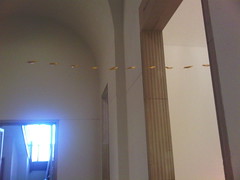
Cai Guo-Qiang - Autumn and 99 Golden Boats
I’ve been cohabiting with Cai Guo-Qiang’s exhibition at The Fabric Workshop and Museum for nearly four months, until it closed yesterday. But I only just took the time to see his installation at Philadelphia Museum of Art. Light Passage comprised four gunpowder drawings—Winter, Spring, Summer, and Autumn. Suspended from the ceiling was 99 Golden Boats, a series of diminutive vessels winding the length of the gallery. They were installed in the Honickman Gallery at PMA, part of an arterial corridor that runs through the modern and contemporary wing.

Cai Guo-Qiang - 99 Golden Boats
The gunpowder drawings themselves are perfectly decent examples of the work for which he has become most famous. Having seen the man lay out and ignite a drawing in person is truly a once-in-a-lifetime experience. These particular pieces contrast the energetic forms Cai achieves with freehand-scattered gunpowder with the crisper-shaped figures attained by outlining the gunpowder with stencils. However, I believe that the works have been selected specifically for what they represent and how they fit within the themes guiding the project, rather than for their individual artistic merits. The leitmotif at both institutions has been lifecycles and the passage of time (in honor of the late Director Anne d’Harnoncourt), so what better way to represent this than with a series of drawings about the four seasons? Well, for one thing, it feels overtly facile and too darn literal.

Looking towards Light Passage with 99 Golden Boats hanging above
On the other hand, I liked the selection of 99 Golden Boats. They chart a snaking course which begins outside of the gallery, leading the viewer in and through the space, constantly looking up. If anything, they do not resemble boats as much as gilt cephalopods, propelling themselves in sequence through invisible liquid. The work has a light, energetic optimism—one can imagine these boats borne upon some imaginary stream as they head forward to a destination unknown. Its obvious counterpoint is Time Scroll at FWM, the manmade river holding his gunpowder drawing about Anne d’Harnoncourt’s life which the flowing water is meant to wash away with time.
Cai Guo-Qiang - Fallen Blossoms: Explosion Project, December 11, 2009
Video by Carlos Avendaño
The direct contrast of these two works solidified for me the distinct overall tones at each respective institution in the collaborative effort to host Cai in Philadelphia. The feeling at PMA came over as invigorating jubilance: the Fallen Blossoms explosion event in December celebrated Anne and her life, expressed in a transient, violent, and masculine burst of energy; the gallery works also felt full of the same lively spirit. Whereas the exhibition at FWM was, by comparison, more solemn and elegiac: the river mournfully wiped away memories of Anne, oblivious to the degradation it inflicted; the tapestry weaving studio offered meditative visual representations from her life, created through an inescapably deliberative process and with an age-old medium traditionally ascribed to feminine gender role.
For my previous post on Cai Guo-Qiang at FWM, click here.
No comments:
Post a Comment